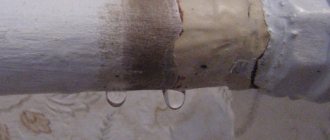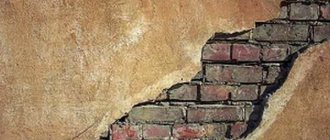During a major or cosmetic repair, it is very useful to know how to repair a crack in a wall, because without rough preparation, further work is useless. Even a small crack requires special attention, since over time it will increase, leading to serious consequences. When starting to eliminate a crack, it is important to take into account its width and depth, the material of the wall, since the methods and tools used in each individual case may differ. In addition, after eliminating the defect, the restored surface must be properly cared for.
Required tools and materials
To seal cracks you will need the following material:
- wood glue in the consistency of thin sour cream, mixed with tooth powder or chalk chips;
- strips of cotton fabric, gauze, medical bandage, soaked in PVA glue (they can be replaced with fiberglass tape);
- cement mortar mixed with paint prevents moisture penetration;
- lime-cement mortar reinforced with mesh;
- sandpaper for grouting;
- primer;
- sealant;
- putty mixture;
- polyurethane foam;
- plaster for finishing.
Preparation of cement mortar for sealing gaps, cracks, seams
Tools you will need:
- brush;
- brush;
- putty knife;
- construction mixer;
- foam sponge;
- gun for sealant and polyurethane foam.
Tools needed for putty
In some cases, the work will additionally require a hammer, chisel and a hammer drill with attachments.
How to seal a gap
In construction practice, cement, rubber, polyurethane foam, sealant, and various types of mastics are used to seal cracks. Their goal is to evenly fill the space and prevent the penetration of moisture and wind into the rupture areas.
If damage to the load-bearing structures of an apartment building does not require major repairs, everyone has the opportunity to repair the damage using a grinder, chisel, hammer, spatula, sealant, masking tape and putty. To seal gaps in panel houses, you need to perform the following steps:
- Drill a hole along the edges of the crack (so that the source of destruction does not increase over time). When performing this operation, the fittings may be damaged. Vulnerabilities should be identified in advance.
- Using a chisel or grinder, create a 10 mm chamfer (beveled corners).
- Remove dust using a vacuum cleaner or broom.
- Treat the surface with a primer.
- After the primer has dried, you can stick on the paint mesh and apply putty. If the wall is cracked to a significant extent, you will need to fill the void with cement mortar.
- Re-prime the restored area. If the gap reappears, it is best to contact a specialist.
How to repair a crack: types of mixtures
In order to choose what to cover cracks in the wall with, you need to take into account the features of the coating:
- To eliminate damage in concrete and brick walls, a cement-sand mixture and its varieties are used, but it is better to add plasticizers to it.
- To restore the coating of plastered walls, plaster and putty compounds are used, the most popular of which are cement and gypsum.
- To eliminate small gaps, acrylic-based sealants are used.
You can get rid of a small crack using sealant - Cracks in drywall are sealed with a putty mixture, and in wooden surfaces they should first be caulked, then a special wood putty should be applied.
Checking cracks for the possibility of further growth
When starting to repair cracks in concrete walls (or those built from other materials), you need to make sure that they are stable, because if the cracks grow, then it makes no sense to cover them up until the destructive process stops.
It is recommended to begin eliminating defects only after the house has completely settled and the factors that caused the phenomenon have been accurately determined.
It is possible to determine how cracking occurs in a simple way. Then proceed like this:
- glue plain paper onto the seam and monitor its integrity for a certain period of time;
- Apply a layer of plaster and wait for the result.
Growth test using gypsum
If the applied coating remains intact, then the defects are covered. With further deformation of the surface, it is necessary to look for the cause in order to stop the growth and seal the gap.
How to dilute the solution yourself
Cracks in walls can occur both outside and inside the building. Therefore, there are two main types of mortar - plaster for external and internal work.
I. Mortar for sealing cracks outside the building
Restoring the integrity of the surface of the walls outside the building is carried out using cement mortar plaster. It is prepared as follows: use cement and sand in a ratio of 1 to 3, add PVA glue, dilute with water to a medium-thick consistency. You can use ready-made dry solutions, which just need to be diluted with water in the ratio indicated on the package.
II. Interior solution
For interior work, lime mortar is used: lime and sand are mixed in a ratio of 1 to 4, diluted with water. The consistency should be such that when thrown onto the wall, the mixture forms a dense “pancake” and not a lump.
What do we offer
Our company can offer ]sealing of walls[/anchor] for high-rise work. Teams of our industrial climbers work in Moscow and the Moscow region. Frequently asked questions about sealing seams: / The management company does not fulfill its obligations, where can I turn? / Practice of filing an application to the Court for sealing seams / Sample application to the Management Company for repair of interpanel seams / Secrets of correctly writing an application for interpanel seams in the Criminal Code / Who should repair a balcony in a privatized apartment? / List of basic works for routine repairs and operation of buildings and structures / Seams in a panel house are leaking, sample application / How to force the management company to seal interpanel seams? / Who should repair the interpanel seams in the house? / Seams in a panel house are leaking, sample application / Time frame for major repairs of interpanel seams
Using polyurethane foam
Large gaps in walls, for example, made of brickwork, can be sealed using polyurethane foam. The gap is first cleared of debris, filled with primer, then foam. When the polyurethane foam “sets,” it is cut to a depth of about 20 mm, and cement mortar or adhesive is placed in this gap.
Foam is also used to seal through gaps in temporary buildings.
Question:
What nuances do you need to know when using polyurethane foam to repair cracks?
Answer:
When working with polyurethane foam, you should remember that too much of it leads to an increase in the crack, and its remains should not stick out out of the gap. It is added not as a single filling, but in stages, for those areas where it is not enough. Excess foam is cut off, the gap is waterproofed, the outside is covered with cement mortar, and the inside is plastered.
Foaming a large gap between the wall and the ceiling
Drawing up an application to the Criminal Code
There is no standardized sample document, but there is a list of information that must be present in the application:
- the personal details (full name) of the general director of the management company are indicated;
- personal details of the applicant, methods of contacting him (mobile phone, email);
- if there are spelling and information errors, the application may be rejected;
- the essence of the statement, the current problem. Preference is given to complaints that indicate a violation of the law.
Crack sealing method
Repairing cracks in walls is carried out using different methods, depending on the type of surface. Let's consider the details of eliminating gaps on surfaces made of various materials.
In brickwork
Repairing cracks in brick walls is carried out in different ways, depending on the size of the damage. If the width of the defect is up to 5 mm, you can get rid of it using cement mortar or regular tile adhesive. The gap is widened with a spatula or hammer and cleaned of dirt. The gap is treated with a primer, then filled with cement or adhesive mortar.
To eliminate cracks 10-15 mm wide, a cement-based solution is also used, but with the addition of fine sand. Sickle tape is glued over the repaired area and putty is applied.
In a plastered wall
Plaster can crack both outside and inside the house.
In any case, the restoration procedure begins with widening the cracks and deepening them with a spatula or a sharp knife. Next, the gap is cleaned of contaminants and primed with a deep penetration solution. When the primer has dried, the plaster mixture is placed inside the gap to its entire depth. Without waiting for the solution to dry, reinforcing tape is glued over the crack and covered with plaster. For repairs, it is recommended to use a gypsum mixture. When the plaster layer dries, it is rubbed with sandpaper for complete leveling.
On sheets of drywall
Cracks in drywall may appear due to too thick a layer of applied plaster or a violation of the thermal regime when it dries. Vertical and horizontal cracks occur at the joints between sheets due to weakening of the metal frame of the wall or the absence of reinforcing tape.
Reinforcement with metal tape
In the first case, the cracks form a “web”. To get rid of it, you need to remove the damaged layer of plaster and apply a new one, but no more than 2 mm thick. Each layer of plaster must dry thoroughly.
In the second case, you need to carry out a number of actions:
- Use a sharp knife to widen the cracks at a 45-degree angle.
- Fill the gaps with gypsum mortar.
- Apply reinforcing tape over the filled crack.
- The surface is leveled with plaster and sanded with an abrasive mesh before applying a decorative coating.
Repairing cracks between sheets of drywall
DIY repair
Often during repair work you have to deal with unpleasant defects. They are discovered while re-sticking wallpaper or leveling a wall for painting. You can deal with minor flaws yourself. When there are more defects outside than inside the house, it makes the job more difficult. Of course, it is difficult to deal with the cause, but you can try to hide this defect.
Puttying cracks in a monolithic house
To “cure” defects in monolithic walls, you will need the appropriate tools and materials:
- sealing composition (sealant, foam) and concrete mortar;
- putty knife;
- sanding mesh and holder for it;
- brush with stiff bristles;
- jointing tool.
First you need to widen the flaw by beating the edges with a hammer for better adhesion of the crack to the putty. Clean the defect from dust and pour sealant into it, then level the seam with concrete mortar. What to cover with? You can, of course, use only the solution, but the sealing compound will not allow it to appear anymore. After drying, you need to sand any unevenness well.
What is the best way to cover up cracks in a load-bearing block wall?
Smooth cracks appear on the masonry when it is not reinforced. There are several putty options for wall repair. Let's look at some ways to eliminate the defect.
- clean and, if necessary, expand the crack;
- clean from dust;
- using metal E-shaped anchors secured with dowels, strengthen the crack between the blocks;
- add pieces of broken cinder block to the solution (the smaller the better) and plaster the defect.
- widen the crack;
- prime;
- seal with mortar.
For small cracks, it is permissible to use tile adhesive, mounting foam or special foam for blocks.
If there is a straight crack in the corners, how to fix it correctly
A straight corner crack must first be opened, primed with a tenacious “Soil-Contact” primer and the seam sealed. To do this, take the Isogypsum putty on a spatula and rub it well into the flaw. Place a mesh on top of the putty. After drying, smooth out all uneven surfaces.
In a concrete wall
Cement mortar is used to fill gaps on concrete walls. The surface is prepared, cleaned of dirt, the remains of old plaster are removed, then the cracks are carefully filled with mortar. Experts often recommend that before filling a gap with cement mortar, lubricate its internal cavity with PVA glue.
In case of large defects and through cracks, the cracks are filled with mounting foam, sealed from the inside with gypsum mortar, and from the outside with cement-sand plaster. Defects less than 5 mm wide can be sealed with sealant.
How to strengthen the foundation of a building
The sequence of actions is as follows.
- Creation of a ditch around the perimeter of the entire structure. Its depth should be greater than the depth of the foundation.
- The soil is dug out from under the first foundation so that the concrete gets under it.
- Reinforcement and pouring of concrete belt. The reinforcement rods are stuck into the walls of the ditch by 15-20 cm. In the old foundation you need to drill holes for the reinforcement and weld it with the rods.
After sealing large cracks, the condition of the repaired surface is regularly monitored for several months. The video shows an algorithm for restoring cracked masonry using reinforcement.
What to do if the crack is long and deep
How to repair a crack in a wall if it is deep? Slots wider than 15 mm are considered dangerous because... may cause wall destruction. If such gaps appear on the brickwork, the defective area is dismantled and replaced with new masonry. In this case, the bricks are laid in a special, interlocking way, strengthening the rows with pieces of reinforcement.
New masonry will help such a crack
You can protect the wall from destruction due to significant cracks by installing lintels or making metal reinforcement. This method is effective for monolithic concrete walls: metal corners are tightened with long bolts, sometimes it is necessary to install reinforcing belts along the entire perimeter of the room or building. The reinforcing belt is installed before sealing a crack in the wall - under the roof, above the foundation, sometimes in several rows.
Such a crack should be sealed with foam, cement, reinforced with a reinforcing belt
A wide and deep gap in drywall can be filled with gypsum plaster
Characteristics and types
Two types of cracks may appear in the load-bearing structures of an apartment building: open and closed. The first ones are visible to the naked eye, the second ones are visible using special equipment. Any crack can be characterized:
- By type of destruction: ruptures, cuts, crushing.
- By depth: through and external.
- Direction: vertical, horizontal and inclined.
- By time: stable-constant and unstable-constant.
- For reasons: deformation, structural, temperature, external (wind), resulting from wear.
- By opening: small, large, developed, hairy.
How long does it take for the solution to dry?
You can begin finishing the wall only after the repair mortar has completely dried. Drying time depends on the material used. Gypsum plaster dries in about three days. The cement-lime mortar will need from 24 hours to two days. The cement mortar dries in 24 hours, and for facade plaster it will take only 8 hours.
When the material dries, special conditions must be created to prevent repeated cracking: air temperature not higher than +25C, absence of drafts and direct sunlight.
Finishing
The final finishing after repairing cracks and cracks is carried out after the solution has completely dried. The dried mixture is sanded well, leveling it with the rest of the wall surface. Then the primer is applied until it stops being absorbed into the restored area of the surface. After this, you can begin decorative finishing - painting, wallpapering, applying textured plaster, etc.
Finish grout
The consistency of the finishing putty should be dense, but not too thick.
Legislation
If the root cause of the cracks is unknown, the management company or homeowners association draws up a report. To do this, you will need to write an application to the City Housing Inspectorate and wait for a commission .
ATTENTION! In 2010, the Arbitration Court of the Russian Federation ruled that the management company or housing and communal services are responsible for the condition of residential buildings.
If a conflict arises, it is advisable to file a complaint about the action or inaction of the organization. The legislation of the Russian Federation does not prohibit applying to several government agencies at the same time.
However, the complaint must be supported by an inspection report and other supporting documents that can resolve the conflict. Going to court is considered a last resort. However, a court decision that has entered into force is mandatory.
How to care for a restored wall
A wall restored after repair, first of all, must be protected from various mechanical influences - do not move furniture too close to it, hammer nails into places where cracks have been repaired, and protect it from being hit by a door.
You need to wipe the walls carefully so as not to damage the decorative layer of the coating. If the decorative coating is durable, it will be able to protect the wall from various influences that could cause repeated cracking, provided that the crack was repaired efficiently and the plaster was completely dry before decorative finishing work. Therefore, methods such as coating decorative plaster with colorless varnish, applying waterproof paint to the surface of walls, using wooden, plastic, gypsum panels, and non-woven wallpaper are used.
Controlling the increase in crack size
Due to the fault of the developer
Fluctuation of pressure on the foundation as a result of uneven settlement of the foundation. This is due to insufficient geological surveys or external factors.
The displacement of the soil under an already constructed structure causes shifting loads, which entails inclined cracks. Point compression of the soil also plays a significant role in identifying the causes of cracks, especially in new buildings.
Nearby pits, traffic, dynamic influences are factors that influence the displacement, compression and settlement of the soil. There are cases when soil freezing, combined with insufficient flexural rigidity of the structure, contributes to the appearance of cracks.
Videos on repairing cracks in walls
The main stages of sealing a crack in a plastered wall in a video:
You can find out what materials to use to cover cracks from this video:
The appearance of cracks on the facade of a house or inside it can be caused by various reasons: shrinkage of the foundation, improper rough finishing, disruption of the bricklaying process, the use of low-quality or inappropriate materials, and many others. It is important to notice their appearance in time and take all necessary measures to eliminate defects. A fine network of cracks in the plaster is usually not associated with the danger of wall destruction, but in any case, the process of the appearance of new gaps must be controlled, as well as the increase in their size
Causes
Floor slabs in a panel house (apartment) can be subject to both minor and deep defects .
In order to begin carrying out repair work, it is necessary to find out the causes and nature of the problems. The most likely reasons for the appearance of a crack in an apartment, be it a new building or an old one, are the following:
- Deformation of panels . They arise as a result of operation, since the physical properties of any building material deteriorate over time. As a rule, cracks in panel ceilings expand and lengthen if a number of repairs are not carried out in a timely manner.
- Shrinkage of the building . At the initial level of construction, a process of shrinkage may take place. However, this defect, in most cases, does not pose a danger. As for the appearance of a crack as a result of the natural shrinkage of the structure, it can lead to a partial violation of the rigidity of the entire structure, since the load-bearing capacity weakens several times at once.
It is important to remember that suspended and suspended ceilings will only correct visible defects in the foundation, but will not solve the problem.









